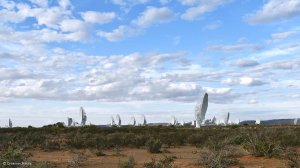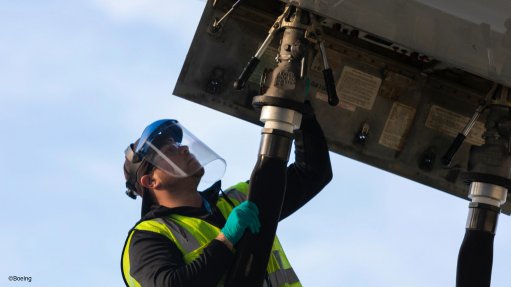SKA South Africa confident radio interference issues with aviation will be solved
South African Radio Astronomy Observatory (SARAO) strategy and business systems head Dr Adrian Tiplady told Engineering News Online on Tuesday that he was certain that concerns regarding radio frequency interference (RFI) on the SKA telescope from aircraft, and the need to maintain aviation safety, would be resolved. "I am confident these issues will be settled."
SKA stands for Square Kilometre Array, and is an international project to design, build and operate the world's largest radio telescope. The SKA will have two core arrays, one in Australia and the other in South Africa, in the Karoo region in the sparsely-populated Northern Cape province. South Africa's precursor instrument to the SKA, the MeerKAT radio telescope array, has now been built and is operating. MeerKAT will, in due course, be incorporated into the SKA.
The SKA will be by far the most sensitive radio telescope ever built, intended to collect very faint radio signals left over from the birth of the universe, more than 14-billion years ago. RFI is thus of huge concern to the SKA programme. It is not merely the issue of interference corrupting or masking data being collected by the instrument. The receivers in the SKA antennas will be so sensitive that RFI from an aircraft could damage, or even destroy, them.
On the other hand, radio broadcasts are essential to aviation safety. Not merely frequent communications between flight crews and air traffic controllers, but the constant transmissions by transponders on aircraft. These transponders not only make it easy to track the aircraft, but also enable, for example, aircraft collision avoidance systems to function.
"Clear cooperation will be required from all parties," affirmed Tiplady. "I believe that the solutions will be a hybrid mix of technical solutions, regulatory solutions and operational solutions. I hope we will start making substantial progress over the next 12 months."
"Obviously, the Department of Science and Technology (DST) and the Department of Transport (DoT) have had a long engagement around the development of a Memorandum of Cooperation, to ensure cooperation between the two departments," he pointed out. There is also a Technical Working Group, with representatives from SARAO, the DST, the DoT -- including the aviation sector, such as Air Traffic and Navigation Services and the South African Civil Aviation Authority. But it has been making slow progress.
Even before the Public Participation Process, which was launched in late 2015, SARAO became aware of the concerns of the wider aviation sector. "With the Public Participation Process, a much wider range of stakeholders made their views known," he observed. "This is the whole point of a Public Participation Process." As a result of concerns raised then and earlier, aviation was excluded from the regulations governing the country's protected astronomy advantage areas, such as that containing the MeerKAT/SKA core site. Appropriate regulations will be developed separately, together with the aviation sector.
"A problem is that some technical analysis is actually quite difficult," he noted. "There is a whole range of transmissions from aviation, at different power levels and at different altitudes. Many analyses rely on technical simulations as well as measurements."
"The key intent for the management of the astronomy advantage areas is managing the radio frequency environment," explained Tiplady. "Obviously, the needs of the emergency and essential services, including aviation, must be provided for. The aim is not to create a radio dead zone over the Northern Cape. The aim is mitigation, not elimination -- to mitigate the impact of aviation signals on the SKA without compromising the safety of aviation services."
In his address to the AVI Afrique Innovation Summit 2018 on Tuesday, he observed that the overarching intent was not to establish a zone that was radio quiet across all the usable spectrum, but instead a zone that enabled optimisation of radio spectrum usage. "Mitigation options are going to be explored with the aviation sector," he assured. "A key aspect of this is ensuring cooperation on the development and implementation of appropriate measures to mitigate the potential impact of RFI from aviation as much as possible."
Comments
Announcements
What's On
Subscribe to improve your user experience...
Option 1 (equivalent of R125 a month):
Receive a weekly copy of Creamer Media's Engineering News & Mining Weekly magazine
(print copy for those in South Africa and e-magazine for those outside of South Africa)
Receive daily email newsletters
Access to full search results
Access archive of magazine back copies
Access to Projects in Progress
Access to ONE Research Report of your choice in PDF format
Option 2 (equivalent of R375 a month):
All benefits from Option 1
PLUS
Access to Creamer Media's Research Channel Africa for ALL Research Reports, in PDF format, on various industrial and mining sectors
including Electricity; Water; Energy Transition; Hydrogen; Roads, Rail and Ports; Coal; Gold; Platinum; Battery Metals; etc.
Already a subscriber?
Forgotten your password?
Receive weekly copy of Creamer Media's Engineering News & Mining Weekly magazine (print copy for those in South Africa and e-magazine for those outside of South Africa)
➕
Recieve daily email newsletters
➕
Access to full search results
➕
Access archive of magazine back copies
➕
Access to Projects in Progress
➕
Access to ONE Research Report of your choice in PDF format
RESEARCH CHANNEL AFRICA
R4500 (equivalent of R375 a month)
SUBSCRIBEAll benefits from Option 1
➕
Access to Creamer Media's Research Channel Africa for ALL Research Reports on various industrial and mining sectors, in PDF format, including on:
Electricity
➕
Water
➕
Energy Transition
➕
Hydrogen
➕
Roads, Rail and Ports
➕
Coal
➕
Gold
➕
Platinum
➕
Battery Metals
➕
etc.
Receive all benefits from Option 1 or Option 2 delivered to numerous people at your company
➕
Multiple User names and Passwords for simultaneous log-ins
➕
Intranet integration access to all in your organisation





















